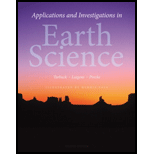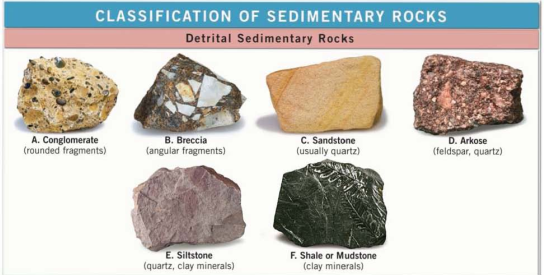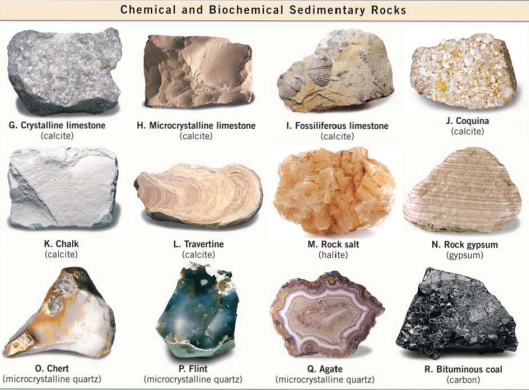
Applications and Investigations in Earth Science (8th Edition)
8th Edition
ISBN: 9780321934529
Author: Edward J. Tarbuck, Frederick K. Lutgens, Dennis G. Tasa, Kenneth G. Pinzke
Publisher: PEARSON
expand_more
expand_more
format_list_bulleted
Textbook Question
Chapter 2.5, Problem 9A
Carefully examine the common sedimentary rocks shown In Figure 2.13. Use these photos and the preceding discussion to answer the following questions.


Sample H is a microcrystalline rock composed of calcite, and Sample O is a microcrystalline rock composed of quartz. What test(s) could be used to figure out which is which?
Expert Solution & Answer
Learn your wayIncludes step-by-step video

schedule03:03
Students have asked these similar questions
Discussion Question: Tectonics, Earthquakes and Volcanism A+
The image below can also be found in your textbook. This image is not an interpretation but an actual picture of the Red Sea. This area of the world is the East African Rift Zone separating
Saudi Arabia and Africa. The linear pattern is due to extensional tectonics. In other words, Africa and Saudi Arabia are moving away from each other creating tensional forces that create
normal faults. The landscape features found in the area are Rift Valleys.
Pretend we are on location at the East African Rift Valley. We would find Normal Faults where one side of the fault shows a rock layer dropped relative to the other layer. We would find
linear mountains that formed from the valley dropping out between the normal faults. The microscale evidence we collect helps to add up to the macroscale interpretation of a divergent
boundary due to tensional forces creating normal faults and rift valleys.
Please explain why low clouds occur off of California’s coast during summer. In your explanation, please include the terms “Hadley Circulation,” “atmospheric subsidence,” and “ocean upwelling''
In Sequoia National Park, why does soil moisture increase in April even though precipitation totals are on average lower in April than in March?
Chapter 2 Solutions
Applications and Investigations in Earth Science (8th Edition)
Ch. 2.1 - Label the rock cycle diagram In Figure 2.3 Figure...Ch. 2.1 - What is magma? How does magma differ from lava?Ch. 2.1 - The terms intrusive and extrusive are used to...Ch. 2.1 - In your own words, write a definition of rock...Ch. 2.1 - Name the process by which sediment is transformed...Ch. 2.1 - What is the most characteristic feature of...Ch. 2.1 - What type of rock is generated when rocks that...Ch. 2.1 - When determining rock composition, describe the...Ch. 2.2 - Which samples A- H exhibits porphyritic texture?Ch. 2.2 - For the samples you listed in Question 1, whal...
Ch. 2.2 - Which samples in Figure 2.9 exhibits...Ch. 2.2 - Complete the description of the environment which...Ch. 2.2 - Which samples in Figure 2.9 exhibits fine-grained...Ch. 2.2 - Complete the description of the environment which...Ch. 2.2 - Which samples in Figure 2.9 exhibits vesicular...Ch. 2.2 - Which samples in Figure 2.9 exhibits glassy...Ch. 2.2 - Although Samples A and C In Figure 2.9 appear...Ch. 2.3 - Prob. 1ACh. 2.3 - Prob. 2ACh. 2.3 - Prob. 3ACh. 2.4 - Prob. 1ACh. 2.5 - Carefully examine the common sedimentary rocks...Ch. 2.5 - Carefully examine the common sedimentary rocks...Ch. 2.5 - Carefully examine the common sedimentary rocks...Ch. 2.5 - Carefully examine the common sedimentary rocks...Ch. 2.5 - Carefully examine the common sedimentary rocks...Ch. 2.5 - Carefully examine the common sedimentary rocks...Ch. 2.5 - Carefully examine the common sedimentary rocks...Ch. 2.5 - Carefully examine the common sedimentary rocks...Ch. 2.5 - Carefully examine the common sedimentary rocks...Ch. 2.5 - What mineral does Sample D contain that gives it a...Ch. 2.6 - Prob. 1ACh. 2.7 - Use Figure 2.16 to identify the environments A- L...Ch. 2.7 - Briefly describe the environment that is...Ch. 2.7 - The rocks in Zion National Park, Utah, consist of...Ch. 2 - The rock samples you encountered while completing...Ch. 2 - Match each of the metamorphic rocks listed below...Ch. 2 - Match each term or characteristics with the...Ch. 2 - Identify the folliated metamorphic rocks shown In...Ch. 2 - Identify each of the rocks shown in Figure 2.26...
Additional Science Textbook Solutions
Find more solutions based on key concepts
16.
a. Calculate the standard free energy change as a pair of electrons is transferred from succinate to mole...
Biochemistry: Concepts and Connections (2nd Edition)
2. Define equilibrium population. Outline the conditions that must be met for a population to stay in genetic e...
Biology: Life on Earth (11th Edition)
Match the following examples of mutagens. Column A Column B ___a. A mutagen that is incorporated into DNA in pl...
Microbiology: An Introduction
A Slice of pizza has 500 kcal. If we could burn the pizza and use all the heat to warm a 50-L container of cold...
Campbell Biology in Focus (2nd Edition)
Why are the top predators in food chains most severely affected by pesticides such as DDT?
Campbell Essential Biology (7th Edition)
1. ___ Mitosis 2. ___ Meiosis 3. __ Homologous chromosomes 4. __ Crossing over 5. __ Cytokinesis A. Cytoplasmic...
Microbiology with Diseases by Body System (5th Edition)
Knowledge Booster
Similar questions
- The continents are net importers of precipitation from the oceans. We know this because, while only 15% of global evaporation occurs from the continents, the continents receive 23% of the globe’s precipitation. How is this discrepancy sustainable without the continents filling up with water and the oceans emptying out?arrow_forward6) Just 15% of global evaporation occurs over the continents even though the continents cover about 29% of the earth’s surface. Why is the proportion of global evaporation that occurs on continents less than 29%?arrow_forwardWhat are the four elements of a local water budget ? Assuming all else is held equal, what is the effect of warming on the atmosphere’s ability to evaporate water from soils and vegetation? What happens to the amount of water stored in the soil if warming affects evapotranspiration in the way you described above and there is no change to runoff?arrow_forward
- The map below shows the age of the ocean floor (time since the crust was formed). Why do we find the youngest ocean crust at the mid-ocean ridges? Why does the oldest crust tend to be near continental coasts?arrow_forwardwhat is a main piece of evidence that the continents were once all connected in a single super continent 200–300 million years ago? What was the main role of plate tectonics in breaking up this super continentarrow_forwardWhat might occur when humans overuse the natural resources of a space or habitat? Question 2 options: Environmental Stability Species Extinction Resource Regeneration Ecological Deficitarrow_forward
- What does natural capital include? Question 3 options: Water, Land, Air Renewable resources Non-renewable resources Culture heritagearrow_forwardNatural Gas is a renewable natural resource. Question 1 options: True Falsearrow_forwardPlease help as soon as possible. I have an answer for this, but I'm a bit confused, so any extra assistance would be appreciated! Complete the cross sections on the front and side of the block diagram in Figure 6.6. Complete the cross-section of the side of the block diagram in Figure 6.7. Complete the front and side of the block diagram in Figure 6.8arrow_forward
- a. Draw four sedimentary layers of equal thickness that have a strike of N90°E. (Hint: Sketch the map view first.)b. Each layer is dipping to the south at an angle of 60°.c. On the block diagram complete the map view and both cross-sectional views.d. Add strike-dip symbols for each rock layer on both parts of Figure 6.9.arrow_forwardThere is an old axiom (a self-evident or universally recognized truth) of economics that “There is no such thing as a free lunch”. In the United States, stringent, enforced water quality laws and regulations provide a high level of protection of our waters. This is accomplished at a significant cost. For example, (sewage treatment plants use 2% of the electricity produced in the United States. This high level of protection increases the cost of goods manufactured in the United States compared to other nations such as China where standards are lower, enforcement a bit lax and in some cases, non-existent. What five (5) things could be done to “level the playing field” so that all manufacturers must provide the same degree of water quality protection no matter where in the world they are located? include how each of your ideas will be implemented (ex: which organization will be provided the power and resources to make sure each idea happens). These should be only about water pollution,…arrow_forwardConnecticut is the only state in America where treated industrial and municipal wastewater cannot be discharged to a surface water body used downstream as a source of drinking water. It is legal in all 49 other states. For example, New Orleans, Louisiana takes its drinking water from the Mississippi River which receives discharges of many, many treated municipal and industrial wastewater discharges as well as agricultural runoff from the more than 20 states that are upstream of it. Should other states be required to adopt Connecticut's standard? Whyarrow_forward
arrow_back_ios
SEE MORE QUESTIONS
arrow_forward_ios
Recommended textbooks for you
 Applications and Investigations in Earth Science ...Earth ScienceISBN:9780134746241Author:Edward J. Tarbuck, Frederick K. Lutgens, Dennis G. TasaPublisher:PEARSON
Applications and Investigations in Earth Science ...Earth ScienceISBN:9780134746241Author:Edward J. Tarbuck, Frederick K. Lutgens, Dennis G. TasaPublisher:PEARSON Exercises for Weather & Climate (9th Edition)Earth ScienceISBN:9780134041360Author:Greg CarbonePublisher:PEARSON
Exercises for Weather & Climate (9th Edition)Earth ScienceISBN:9780134041360Author:Greg CarbonePublisher:PEARSON Environmental ScienceEarth ScienceISBN:9781260153125Author:William P Cunningham Prof., Mary Ann Cunningham ProfessorPublisher:McGraw-Hill Education
Environmental ScienceEarth ScienceISBN:9781260153125Author:William P Cunningham Prof., Mary Ann Cunningham ProfessorPublisher:McGraw-Hill Education Earth Science (15th Edition)Earth ScienceISBN:9780134543536Author:Edward J. Tarbuck, Frederick K. Lutgens, Dennis G. TasaPublisher:PEARSON
Earth Science (15th Edition)Earth ScienceISBN:9780134543536Author:Edward J. Tarbuck, Frederick K. Lutgens, Dennis G. TasaPublisher:PEARSON Environmental Science (MindTap Course List)Earth ScienceISBN:9781337569613Author:G. Tyler Miller, Scott SpoolmanPublisher:Cengage Learning
Environmental Science (MindTap Course List)Earth ScienceISBN:9781337569613Author:G. Tyler Miller, Scott SpoolmanPublisher:Cengage Learning Physical GeologyEarth ScienceISBN:9781259916823Author:Plummer, Charles C., CARLSON, Diane H., Hammersley, LisaPublisher:Mcgraw-hill Education,
Physical GeologyEarth ScienceISBN:9781259916823Author:Plummer, Charles C., CARLSON, Diane H., Hammersley, LisaPublisher:Mcgraw-hill Education,

Applications and Investigations in Earth Science ...
Earth Science
ISBN:9780134746241
Author:Edward J. Tarbuck, Frederick K. Lutgens, Dennis G. Tasa
Publisher:PEARSON

Exercises for Weather & Climate (9th Edition)
Earth Science
ISBN:9780134041360
Author:Greg Carbone
Publisher:PEARSON

Environmental Science
Earth Science
ISBN:9781260153125
Author:William P Cunningham Prof., Mary Ann Cunningham Professor
Publisher:McGraw-Hill Education

Earth Science (15th Edition)
Earth Science
ISBN:9780134543536
Author:Edward J. Tarbuck, Frederick K. Lutgens, Dennis G. Tasa
Publisher:PEARSON

Environmental Science (MindTap Course List)
Earth Science
ISBN:9781337569613
Author:G. Tyler Miller, Scott Spoolman
Publisher:Cengage Learning

Physical Geology
Earth Science
ISBN:9781259916823
Author:Plummer, Charles C., CARLSON, Diane H., Hammersley, Lisa
Publisher:Mcgraw-hill Education,